Key takeaways:
- Town hall meetings promote community engagement, transparency, and empower individuals to take action on local issues.
- Pro-life advocacy is strengthened by sharing personal stories, which can shift beliefs and inspire collective action.
- Creating discussion topics that resonate, incorporating personal experiences and current events, enhances engagement and encourages participation.
- Effective promotion through social media, partnerships with local organizations, and personal connections increases attendance at community events.
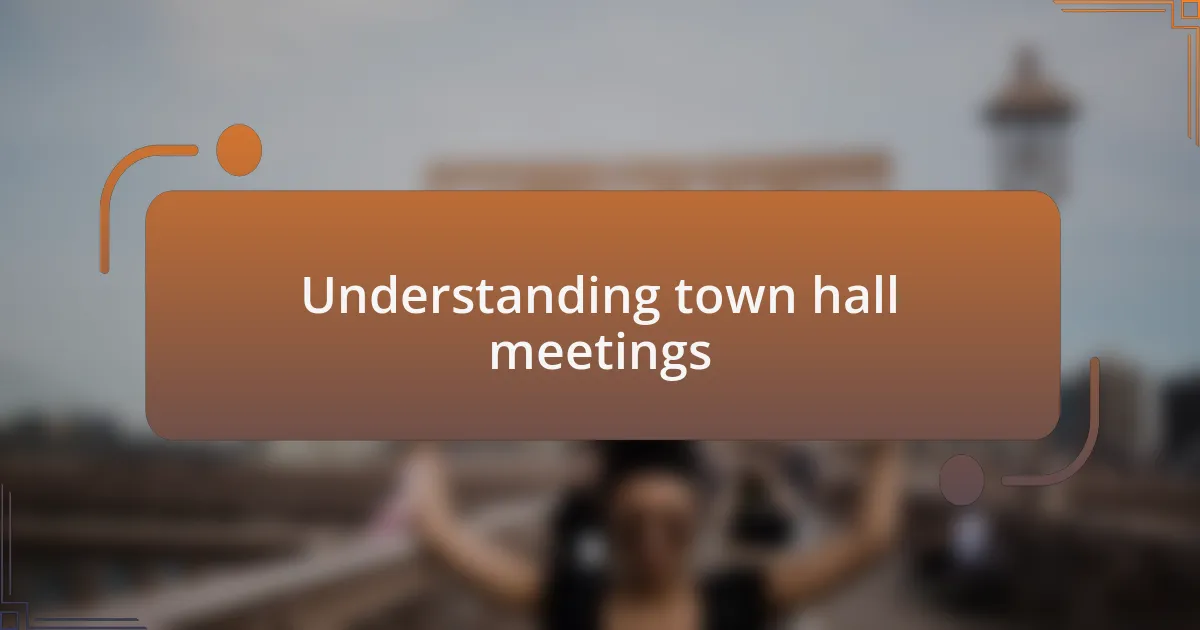
Understanding town hall meetings
Town hall meetings serve as a valuable platform for community engagement, allowing residents to voice their opinions and concerns. I remember attending one such meeting where a local issue was on the table. The room was buzzing with energy, filled with people who were passionate about making a difference—each voice adding a unique perspective to the discussion.
These gatherings foster an environment where transparency is key. I always found it enlightening to witness how open dialogue can bring diverse viewpoints to the forefront. Isn’t it fascinating how hearing someone’s personal story can shift the entire conversation? It highlights the importance of understanding each other’s experiences, especially when discussing topics that affect lives deeply.
Moreover, town hall meetings can empower individuals to take action beyond just expressing their views. I’ve seen community members form alliances right then and there, igniting initiatives that stem from these discussions. It makes me wonder: if we all participated actively in such events, how many profound changes could we instigate together?
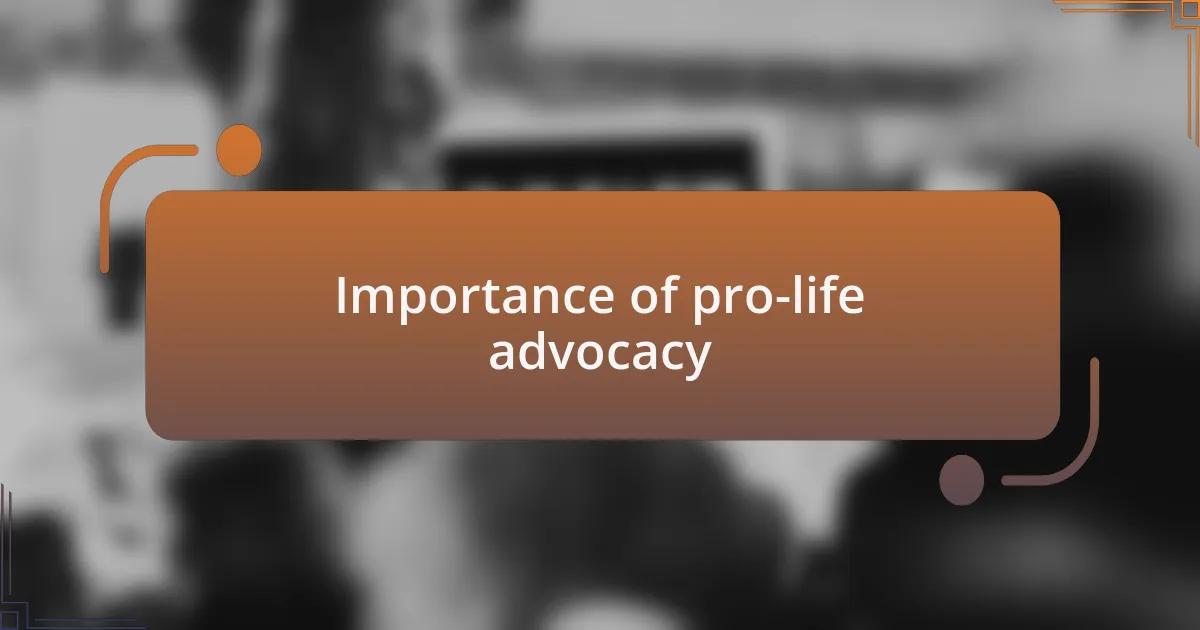
Importance of pro-life advocacy
Pro-life advocacy plays a crucial role in shaping societal perceptions about the value of life. Reflecting on my interactions within the community, I’ve witnessed how sharing stories can profoundly impact beliefs. For instance, during a local event, a mother bravely recounted her journey after choosing life for her child despite overwhelming challenges. That heartfelt narrative shifted minds and stirred emotions, proving how powerful our shared experiences can be in this movement.
The importance of pro-life advocacy extends beyond individual stories; it embodies a collective effort to protect the most vulnerable among us. I recall a pivotal moment in my advocacy work when community members united for a local march, emphasizing our commitment to valuing every human life. Standing shoulder to shoulder with others who shared my passion was inspiring. It reinforced my belief that when we raise our voices together, we create a ripple effect that can influence policy and promote a culture of life.
In my experience, engaging in pro-life advocacy also fosters critical discussions that challenge the status quo. I often find that when we confront uncomfortable topics about life and choice, it can lead to enlightening conversations. Have you ever noticed how these discussions can illuminate perspectives that might have remained hidden? It’s in these moments that barriers break down, and understanding flourishes, reminding us that advocacy is not just about debating; it’s about connecting and empathizing with one another’s journeys.

Engaging community members
Engaging community members starts with creating a personal connection. I vividly remember chatting with my neighbors at a block party about the importance of supporting families and children. By sharing my own experiences, I found that people were more open to discussing their views and concerns. The honest exchange of stories transformed our conversation into something meaningful, illustrating how personal interactions can foster a sense of shared purpose.
In another instance, I hosted a small gathering where we discussed the various challenges faced by pregnant women in our community. I asked attendees to share what they thought could be done to provide better support. The flood of ideas that emerged was astonishing. It was clear that when people feel invited to contribute, they engage more deeply, turning passive listeners into active participants. Have you seen how powerful it is when community members discover their collective voice?
I often think back to community workshops where we gathered not just to talk, but to listen. When we created a safe space for dialogue and reflection, I witnessed transformations in attitudes. It’s like turning on a light in a dark room; suddenly, everything is clearer. By encouraging conversations that center around compassion and understanding, we invite community members to step beyond their comfort zones and embrace a collaborative spirit. Isn’t it remarkable how such engagements can shift perspectives and galvanize action?
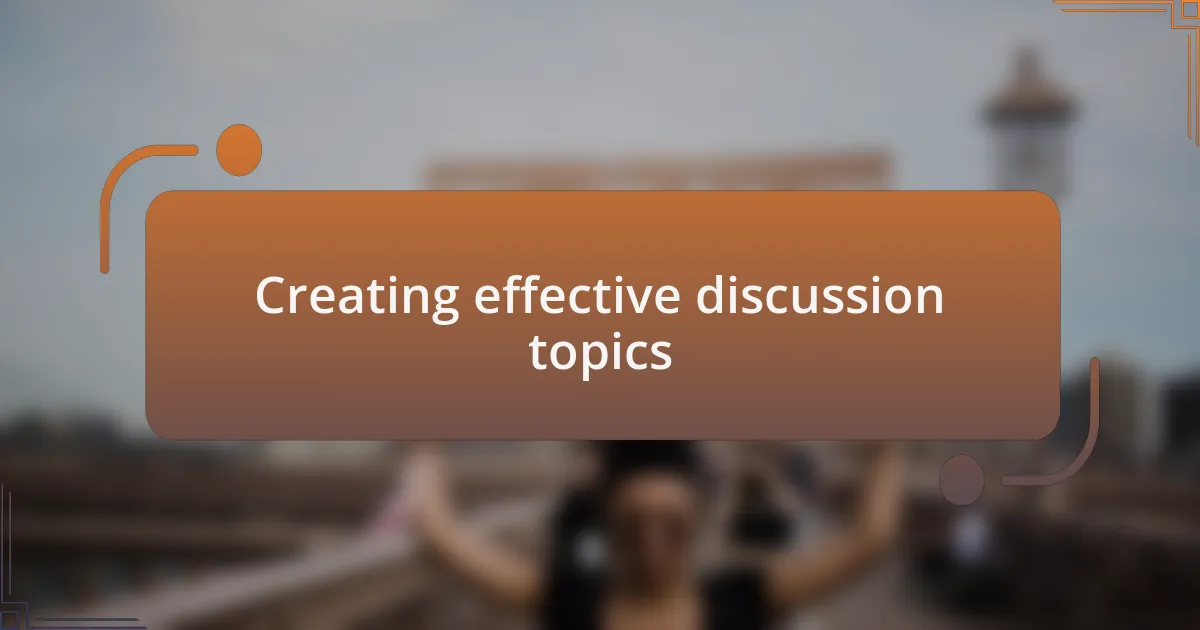
Creating effective discussion topics
Creating discussion topics that resonate with the community is crucial. During my own town hall meeting, I noticed that when I framed discussions around the real-life impacts of proposed policies, participants were much more engaged. For instance, instead of just talking about regulations, we explored how they affected families on a personal level. This approach always invites deeper connections and sparks passionate conversations.
One memorable topic I introduced was the emotional toll of unplanned pregnancies and the need for local resources. I shared a story about a close friend who struggled through that experience, which prompted others to reflect on similar challenges in their lives. Have you ever seen how raw emotions can lead to an energizing dialogue? It’s incredible how personal experiences can shift the tone—suddenly, we weren’t just discussing abstract ideas; we were sharing genuine concerns and possible solutions.
Another effective strategy is to incorporate current events into your discussions. When I brought up recent news about proposed funding cuts for family support services, the room buzzed with immediate reactions. This current relevance made participants feel more connected to the issues at hand. Isn’t it fascinating how timely topics can help illuminate the larger picture and encourage proactive thinking? By continually weaving in personal stories and relevant events, I’ve found that discussions become richer and more productive.
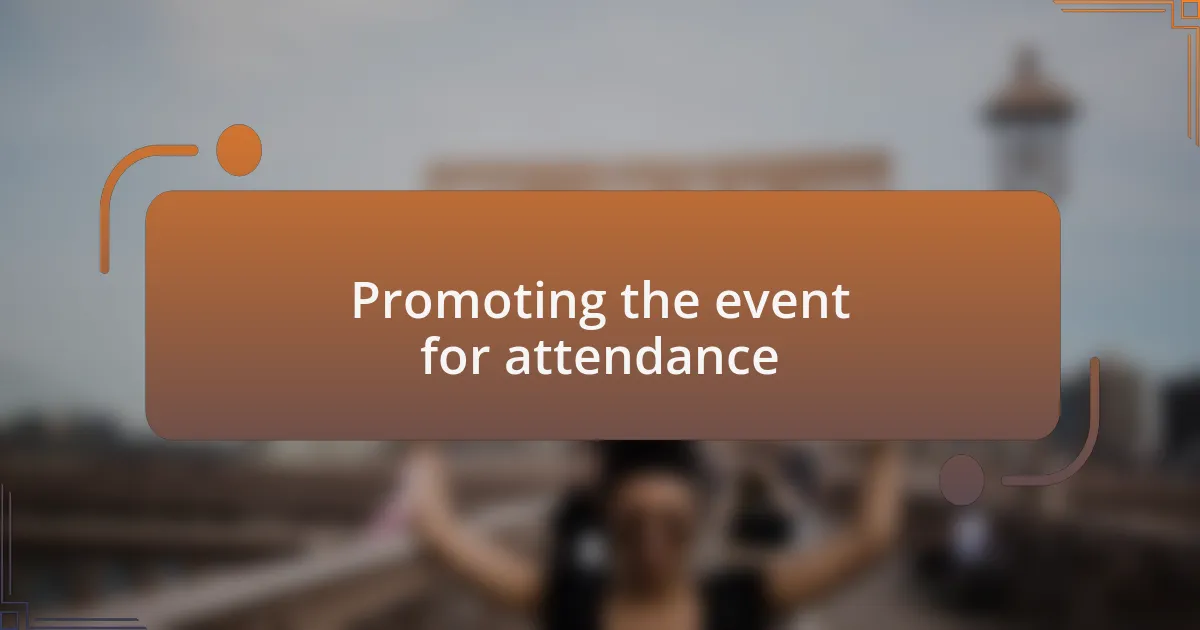
Promoting the event for attendance
To effectively promote attendance at your town hall meeting, leveraging social media can be a game-changer. In my experience, creating an event page on platforms like Facebook or Instagram not only increases visibility but also fosters community engagement. I remember posting a heartfelt video invitation that shared my reasons for organizing the meeting. The responses flooded in, with people expressing their eagerness to attend and share their stories too—it’s amazing how a personal touch can ignite enthusiasm.
I also found that collaborating with local organizations makes a significant impact. By partnering with pro-life groups, we expanded our reach through their networks. For instance, I reached out to a nearby youth group, and they helped distribute flyers and spread the word in their circles. Seeing their support reminded me of how we’re all in this together—working toward common goals strengthens our community bonds. Have you ever thought about how a simple partnership can amplify your efforts?
Lastly, don’t underestimate the power of word-of-mouth. I made it a point to connect with community members one-on-one, sharing the details of the event and inviting them personally. These casual conversations often led to others expressing interest in attending, demonstrating how personal connections can create genuine excitement. Isn’t it interesting how a single conversation can ripple through your network, igniting interest and encouraging attendance?
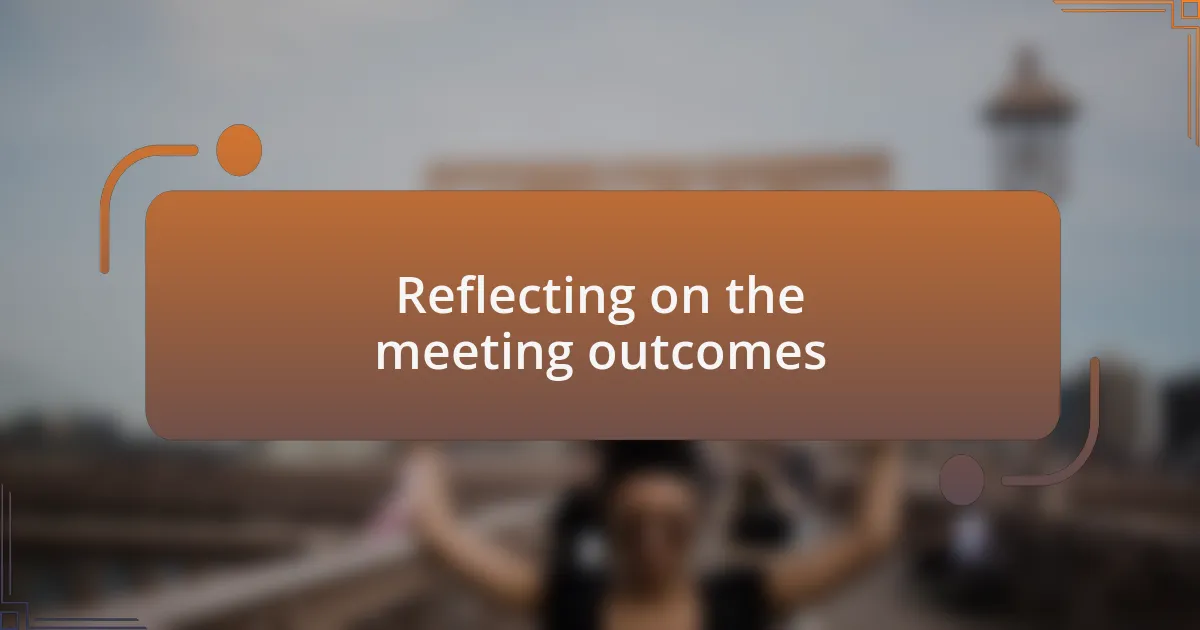
Reflecting on the meeting outcomes
Reflecting on the outcomes of the town hall meeting, I was surprised by the depth of engagement we experienced. As I listened to community members sharing their thoughts, it became clear that this gathering was more than just a formality; it was a platform for genuine dialogue. I recall one attendee, deeply emotional, articulating how the support of our local pro-life community had impacted her life. Isn’t it powerful when voices unite to create a shared purpose?
Analyzing the feedback we received afterward was equally insightful. People expressed their gratitude for being heard and valued, and it reinforced my belief that providing a safe space for discussion can truly empower individuals. I remember jotting down a particular comment about feeling less isolated in their beliefs after attending, which struck a chord with me. Have you ever encountered someone whose perspective shifted simply by knowing they are not alone?
Moving forward, I see clear opportunities to build on this momentum. The conversations sparked at the meeting revealed a strong desire for ongoing dialogue and education within our community. I feel the excitement bubbling up as potential new initiatives emerge from these discussions. What if we could harness this energy to create regular forums for dialogue? Engaging in this way could not only strengthen our efforts but also foster a deeper sense of community solidarity.